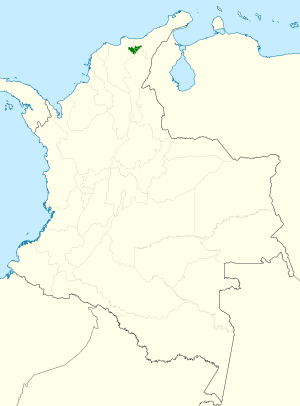Santa Marta wren facts for kids
Quick facts for kids Santa Marta wren |
|
|---|---|
| Conservation status | |
| Scientific classification | |
| Genus: |
Troglodytes
|
| Species: |
monticola
|
 |
|
The Santa Marta wren (Troglodytes monticola) is a special kind of bird that belongs to the Troglodytidae family, which includes all the wrens. This small bird is found only in one place: Colombia. It's a unique bird that lives in a very specific part of the world.
Contents
About the Santa Marta Wren
The Santa Marta wren is often thought of as a close relative of the mountain wren (Troglodytes solstitialis). Scientists group these two wrens, along with the ochraceous wren (T. achraceus), rufous-browed wren (T. rufociliatus), and tepui wren (T. rufulus), into a special group called a superspecies. This means they are all very similar and likely share a common ancestor. The Santa Marta wren itself is considered "monotypic," which means it doesn't have any different subspecies.
What Does It Look Like?
The Santa Marta wren is about 11.5 cm (4.5 in) long, which is roughly the size of a small sparrow.
- Its head and back are a reddish-brown color.
- The lower part of its back has dark, thin lines.
- Its tail is brown and also has dark lines.
- It has a light, yellowish-brown stripe above its eye, called a supercilium, and a light ring around its eye.
- Its chin is very pale, becoming a yellowish-brown on its throat and chest.
- The sides of its body are yellowish-white with dark brown stripes.
- The area under its tail is white with dark stripes.
Young Santa Marta wrens look similar to the adults but have dark tips on the feathers of their back and belly.
Where Does It Live?
The Santa Marta wren lives only in the Sierra Nevada de Santa Marta mountains in northern Colombia. It likes to live in certain types of places:
- The edges of "elfin forests," which are forests with small, twisted trees.
- Areas called páramo, which are high-altitude grasslands and shrublands.
- Scrubby areas right where the trees stop growing, known as the tree line.
You can find these birds at very high elevations, from about 3,200 to 4,800 m (10,500 to 15,700 ft) up in the mountains.
How It Behaves
Feeding Habits
The Santa Marta wren looks for its food from the ground up to the middle parts of trees and bushes. Sometimes, it even joins mixed species foraging flocks, which are groups of different bird species that search for food together. Scientists don't have much information yet about what exactly this wren eats.
Life Cycle and Reproduction
Unfortunately, scientists haven't published much information about how the Santa Marta wren breeds or its full life cycle. We don't know details like when they lay eggs or how they raise their young.
Sounds and Songs
The song of the Santa Marta wren hasn't been officially described by scientists. However, its call is a repeated sound that people describe as "di-di."
Its Survival Status
The IUCN (International Union for Conservation of Nature) has listed the Santa Marta wren as "Critically Endangered." This means it's at a very high risk of disappearing forever.
- There are fewer than 250 adult Santa Marta wrens left in the wild.
- Even though much of its home is inside the Sierra Nevada de Santa Marta National Park, which is supposed to be protected, its habitat is still being destroyed.
- Problems like forests being cut down, too many animals eating the plants (overgrazing), and fires continue to happen in its living areas. Protecting this special bird and its home is very important.
See also
 In Spanish: Cucarachero de Santa Marta para niños
In Spanish: Cucarachero de Santa Marta para niños


